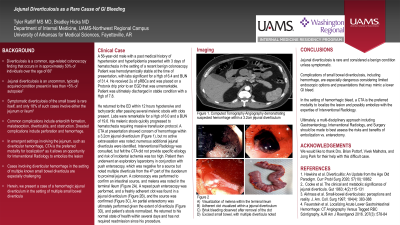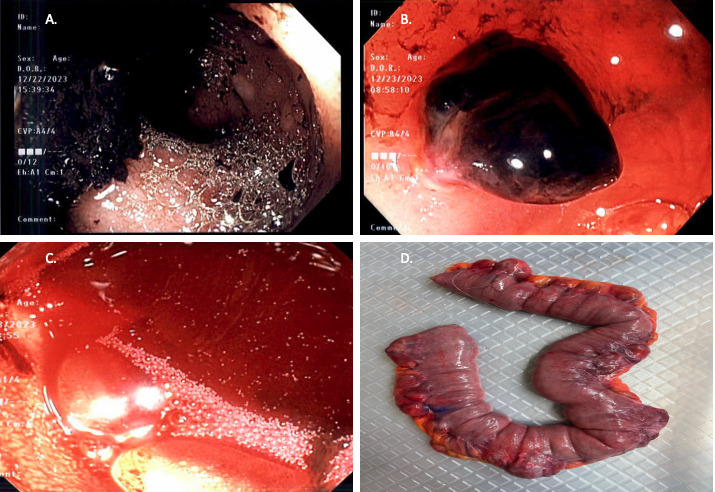Monday Poster Session
Category: Small Intestine
P3273 - Jejunal Diverticulosis as a Rare Cause of GI Bleeding
Monday, October 28, 2024
10:30 AM - 4:00 PM ET
Location: Exhibit Hall E

Has Audio

Tyler Ratliff, MS, MD
University of Arkansas for Medical Sciences
Fayetteville, AR
Presenting Author(s)
Award: Presidential Poster Award
Tyler Ratliff, MS, MD, Bradley Hicks, MD
University of Arkansas for Medical Sciences, Fayetteville, AR
Introduction: Diverticulosis is a common colonoscopy finding that is age-related and occurs in approximately 60% of individuals over the age of 70. Diverticula involving the small bowel are rare, as these diverticula are found in less than 1% of autopsies and are typically asymptomatic. Bleeding complications involving diverticula in small bowel locations are especially dangerous as they cannot be approached via typical endoscopic methods. Herein, we describe a case of hemorrhagic bleeding involving a jejunal diverticulum requiring an enterectomy.
Case Description/Methods: A 56-year-old male presented to the ED hypotensive and anemic after 3 days of hematochezia and weakness. Patient had a colonoscopy 9 days prior to his presentation which was unremarkable other than sigmoid diverticulosis and internal hemorrhoids. Following admission, EGD was normal and subsequent nuclear tagged RBC scan showed no evidence of bleeding. Two days later, he began to pass both bright red and melenic stool, ultimately requiring massive transfusion protocol. A CTA revealed bleeding within a 3.2 cm jejunal diverticulum without evidence of active arterial extravasation. Interventional Radiology was consulted, though no embolization was performed in the absence of a definitive source. General Surgery was consulted. Due to hemodynamic instability, an exploratory laparotomy with push endoscopy was performed. This revealed multiple jejunal diverticula though no active source was found. A repeat colonoscopy showed melena in the terminal ileum, confirming a small bowel source. The following day, the patient was taken back to the operating room for wound closure where a repeat laparotomy with push endoscopy was performed. A fresh clot was found in a jejunal diverticular sac. Following removal of the clot, brisk bleeding was observed. This confirmed the source. Partial enterectomy was then successfully completed with no further bleeding since discharge.
Discussion: Jejunal diverticulum are rare and typically asymptomatic in the general population, usually found incidentally via autopsy or laparotomy. Bleeding from jejunal diverticulum is an exceedingly rare but dangerous complication, as they may present with symptoms mimicking a lower GI bleed and cannot be evaluated via conventional EGD. Once jejunal diverticulosis is identified, a multi-disciplinary approach involving GI, Interventional Radiology, and Surgery should be made to best assess the risks and benefits of embolization vs. enterectomy.

Disclosures:
Tyler Ratliff, MS, MD, Bradley Hicks, MD. P3273 - Jejunal Diverticulosis as a Rare Cause of GI Bleeding, ACG 2024 Annual Scientific Meeting Abstracts. Philadelphia, PA: American College of Gastroenterology.
Tyler Ratliff, MS, MD, Bradley Hicks, MD
University of Arkansas for Medical Sciences, Fayetteville, AR
Introduction: Diverticulosis is a common colonoscopy finding that is age-related and occurs in approximately 60% of individuals over the age of 70. Diverticula involving the small bowel are rare, as these diverticula are found in less than 1% of autopsies and are typically asymptomatic. Bleeding complications involving diverticula in small bowel locations are especially dangerous as they cannot be approached via typical endoscopic methods. Herein, we describe a case of hemorrhagic bleeding involving a jejunal diverticulum requiring an enterectomy.
Case Description/Methods: A 56-year-old male presented to the ED hypotensive and anemic after 3 days of hematochezia and weakness. Patient had a colonoscopy 9 days prior to his presentation which was unremarkable other than sigmoid diverticulosis and internal hemorrhoids. Following admission, EGD was normal and subsequent nuclear tagged RBC scan showed no evidence of bleeding. Two days later, he began to pass both bright red and melenic stool, ultimately requiring massive transfusion protocol. A CTA revealed bleeding within a 3.2 cm jejunal diverticulum without evidence of active arterial extravasation. Interventional Radiology was consulted, though no embolization was performed in the absence of a definitive source. General Surgery was consulted. Due to hemodynamic instability, an exploratory laparotomy with push endoscopy was performed. This revealed multiple jejunal diverticula though no active source was found. A repeat colonoscopy showed melena in the terminal ileum, confirming a small bowel source. The following day, the patient was taken back to the operating room for wound closure where a repeat laparotomy with push endoscopy was performed. A fresh clot was found in a jejunal diverticular sac. Following removal of the clot, brisk bleeding was observed. This confirmed the source. Partial enterectomy was then successfully completed with no further bleeding since discharge.
Discussion: Jejunal diverticulum are rare and typically asymptomatic in the general population, usually found incidentally via autopsy or laparotomy. Bleeding from jejunal diverticulum is an exceedingly rare but dangerous complication, as they may present with symptoms mimicking a lower GI bleed and cannot be evaluated via conventional EGD. Once jejunal diverticulosis is identified, a multi-disciplinary approach involving GI, Interventional Radiology, and Surgery should be made to best assess the risks and benefits of embolization vs. enterectomy.

Figure: A. Melena observed within the terminal ileum, indicating the small bowel as the bleeding source
B. A fresh, adherent clot was observed within one of the jejunal diverticula
C. Blood rapidly filled the jejunum after dislodging the diverticular clot
D. Section of the proximal jejunum after successful enterectomy, with many prominent diverticula present
B. A fresh, adherent clot was observed within one of the jejunal diverticula
C. Blood rapidly filled the jejunum after dislodging the diverticular clot
D. Section of the proximal jejunum after successful enterectomy, with many prominent diverticula present
Disclosures:
Tyler Ratliff indicated no relevant financial relationships.
Bradley Hicks indicated no relevant financial relationships.
Tyler Ratliff, MS, MD, Bradley Hicks, MD. P3273 - Jejunal Diverticulosis as a Rare Cause of GI Bleeding, ACG 2024 Annual Scientific Meeting Abstracts. Philadelphia, PA: American College of Gastroenterology.


